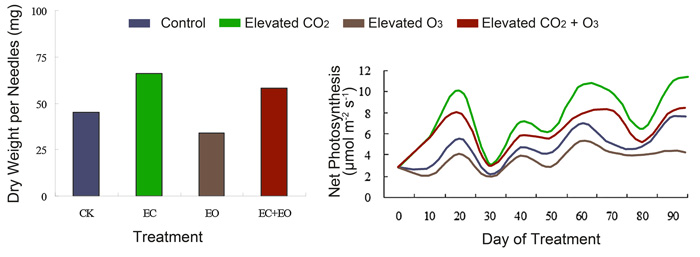| Tweet | Follow @co2science |
Paper Reviewed
Liu, Z., Chen, W., He, X., Fu, S. and Lu, T. 2016. Regulatory effects of elevated carbon dioxide on growth and biochemical responses to ozone stress in Chinese pine (Pinus taulaeformis Carr.). Bulletin of Environmental Contamination and Toxicology 97: 793-797.
In an attempt to downplay the many benefits of atmospheric CO2 enrichment on plant growth and development, climate alarmists frequently contend that the positive responses induced by rising levels of CO2 will be negated by the negative impacts of rising levels of ozone (O3) pollution. However, as evidenced by the many studies we have previously reviewed on this topic (see, for example, those reviews posted under the various subheadings of Ozone: Effects on Plants, listed here), elevated CO2 reduces, and nearly always completely overrides, the negative effects of O3 pollution on plant photosynthesis, growth and yield.
The latest study to illustrate as much comes from the work of Liu et al. (2016), who examined the impact of elevated CO2 and O3, both alone and in combination, on Chinese pine (Pinus tabulaeformis). As the dominant species of the coniferous forest in northern China, covering close to 3 million square kilometers, this tree species is of significant regional ecological and economic importance.
The work of the five Chinese researchers was conducted in open top chambers at the Shenyang Botanical Garden of the Chinese Academy of Sciences, where they grew four-year-old P. tabulaeformis seedlings under four different treatment conditions of ambient (370 ppm) or elevated (721 ppm) CO2 and/or ambient (41.5 nmol mol-1) or elevated (82.6 nmol mol-1) O3 for a period of 90 days. At various intervals during their short-term experiment, the scientists measured the net photosynthetic rates of the plants. They also measured parameters pertaining to plant dry weight, cell membrane damage and oxidative stress. And what did their measurements reveal?
As shown in the figure below, Liu et al. report that "after 90 days exposure to elevated CO2, dry weight showed a significant increased trend, indicating that the elevated concentration of CO2 improved plant growth." Not surprisingly, tree seedlings exposed to elevated O3 experienced dry weight declines. Under the combined elevated CO2 and O3 treatment, however, the benefits of CO2 on growth overpowered the negative effects of O3, producing dry weight values that were not significantly different from those under elevated CO2 conditions alone.
Similar CO2-induced enhancements were reported for net photosynthesis and in measurements of antioxidative enzymes that gauge O3 cellular damage. These findings led the authors to conclude that the results of their analysis "demonstrated that growth, photosynthesis and antioxidative system of the plant were positively affected by elevated CO2" and that elevated CO2 helps to "ameliorate oxidative stress and reduce injury by O3." Thus, we have yet another example of how the positive growth enhancements of elevated CO2 are sufficient to negate and overpower the negative growth declines of elevated ozone.

Figure 1. Effect of elevated CO2 and O3, alone and in combination, on biomass dry weight (left panel) and net photosynthetic rate (right panel) of P. tabulaeformis. Abbreviations for treatment conditions include CK for control, EC for elevated CO2, EO for elevated O3 and EC + EO for elevated CO2 and O3. Adapted from Liu et al. (2016).




